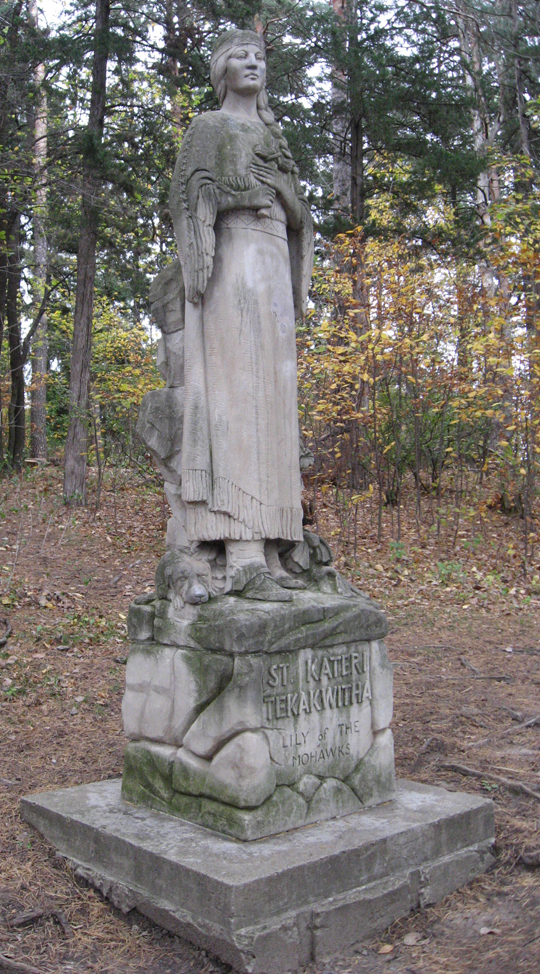 It’s proper, as an Anabaptist hanging out at a Benedictine monastery, to seek spiritual stimuli around every corner. During my week as a recipient of Benedictine hospitality at Saint John’s Abbey and University, I take in the abbey church, peer into the confessionals, and gently touch the icons. One afternoon, recommendations for the famous “chapel walk” ringing in my ears, I hustle to the trail, expecting to commune with clusters of trees, eavesdrop on rowdy waves, and encounter Mary, pregnant teenager, in her chapel overlooking Lake Sagatagan.
It’s proper, as an Anabaptist hanging out at a Benedictine monastery, to seek spiritual stimuli around every corner. During my week as a recipient of Benedictine hospitality at Saint John’s Abbey and University, I take in the abbey church, peer into the confessionals, and gently touch the icons. One afternoon, recommendations for the famous “chapel walk” ringing in my ears, I hustle to the trail, expecting to commune with clusters of trees, eavesdrop on rowdy waves, and encounter Mary, pregnant teenager, in her chapel overlooking Lake Sagatagan.
 Rushing around the first bend, fretting that I’ll be late for dinner, I stop short at a statue towering over the trail – not the swollen Madonna, but the lanky Saint Kateri Tekakwitha, dog at her moccasined feet, braids in her hair. I spy “Mohawk” in the statue’s inscription and smile inwardly at what seems like awkward multiculturalism for a German institution whose founders displaced the Indians once living here. I pull out my cell phone for a photo. I take three big steps back to get the statue’s full frame, capturing the inscription to read some other time. Click. Being mostly German myself, I note ironic tension as I post the photo to Facebook for my friends back home.
Rushing around the first bend, fretting that I’ll be late for dinner, I stop short at a statue towering over the trail – not the swollen Madonna, but the lanky Saint Kateri Tekakwitha, dog at her moccasined feet, braids in her hair. I spy “Mohawk” in the statue’s inscription and smile inwardly at what seems like awkward multiculturalism for a German institution whose founders displaced the Indians once living here. I pull out my cell phone for a photo. I take three big steps back to get the statue’s full frame, capturing the inscription to read some other time. Click. Being mostly German myself, I note ironic tension as I post the photo to Facebook for my friends back home.
Dashing down the next hill I reach a bridge. A cheerful chap is baiting his fishing line, so I tip-toe past him. Near the shore, dozens of yellow blossoms eagerly stretch toward the sun. I pull out my phone and explain to the fisherman, “I’m mesmerized by lily pads,” not wanting to talk but not wanting him to think I’m taking his picture. Click. I pivot and crouch. Click.
Hastening up the next hill I realize how ridiculous I sound. Mesmerized? I took two quick shots and scampered past the lilies.
Point and click is how we in dominant cultures repeatedly encounter people who are different from us in matters of deep identity, such as race and ethnicity.
Yet point and click is how we in dominant cultures repeatedly encounter people who are different from us in matters of deep identity, such as race and ethnicity – even in caring relationships. White people in my culture easily tokenize (“I have a black friend who says…”), objectify (“Isn’t it wonderful that these Hispanic kids from the neighborhood are coming to church?”), fetishize (“I just love the exotic thrill of their music!”), and commodify (“Look how many of my Facebook friends are people of color!”).
Racing camera in hand as a guest around this lake awakens me to the hell of my good intentions.
While marginalized people are not a forest, and people of color are not the myriad life within it, my walk in the woods is a lesson in interculturalism – not merely welcoming people of other cultures, but practicing the radical hospitality of taking turns as guests and hosts. Racing camera in hand as a guest around this lake awakens me to the hell of my good intentions. Snapping commodifying photos doesn’t hurt lilies, but collecting cross-cultural experiences and consuming other cultures does plenty of harm.
Most white people dabble in multiculturalism as consumers – soaking up various genres of music, devouring unfamiliar delicacies at restaurants, collecting trinkets while traveling, amassing photos and stories from exotic adventures. The purpose of these experiences is our own moral edification, intellectual enlightenment, spiritual evolution, and aesthetic pleasure. We continually expect people of color to take the time, do the work, and risk vulnerability to teach us about ourselves.
A rustle in the bushes catching my ear, I pivot and peer into the dim forest, squinting through the bright sunlight. A vibrant turtle ambles through the underbrush, orange zigging up its legs, yellow zagging down its head. Click.
Wait, shouldn’t it shuffle toward the lake? Maybe my alien presence confused the turtle, and it’s frantically seeking shelter? If this is my fault, shouldn’t I intervene?
We are multicultural when we appreciate other cultures; we are intercultural when we open ourselves to other cultures changing us.
Well-intentioned white people grapple with this conundrum, and though our hearts are moved to engage, we reach for easy answers and self-righteous suggestions. Assuming that others want our help is patronizing. Once invited into a community or family or story, we must listen and learn, and share our own stories before we share any suggestions. We are multicultural when we appreciate other cultures; we are intercultural when we open ourselves to other cultures changing us.
Humbly, I recall that turtles have meandered through these woods long before my family got to this country, and will be dawdling long after I’m dead.
Relationships, even simple interactions, in which we have open eyes to see a person as unique, open minds to learn of realities that threaten all of us, and open hearts to be shaped by another—are the core of human understanding. White people like me often want to feel intercultural more than we want to risk our own culture. We want to appear cosmopolitan more than we want to shed our provincialism. We want to be allowed to change others without being vulnerable enough to be changed. Who captures me with a click as I wander through this world, which is always mine and never mine?
The chapel walk’s next bridge cannot be conquered by my camera. Sure, I could show you a picture of it, but you wouldn’t see how it lurches beneath me, how its lack of railings conjures images in my mind of plummeting into Lake Sag, how it ripples with each step I take and forces me to notice, slow down, change.
When relationships transform us we cannot control who we become.
Just like the black Baptist with whom I share my hand, heart, and years sees me and shakes me to my very core, forcing me to notice, slow down, change. When relationships transform us we cannot control who we become. Loving a black man does not prove that I’m not racist – it forces me to confront my white privilege each day. For white people, being intercultural is as much about meaningfully engaging people of color as it is about being fully aware of our whiteness.
The bridge sways under my weight; I move with care. The bridge pulses against my steps; I accept that I am not in control. The man I love does more than pulse against me, he throws me off balance, supports my weight, enjoys our bounce. His voice is the first and last I hear each day.
I w onder how many more twists and turns will take me to Mary’s chapel. I looked at a map before I left, but I left the map behind. As we engage in earnest intercultural relationships, rushing in naively is a mistake, but so is over-determining outcomes. Squarely facing the complexity of living and loving in a segregated, stratified world, we see how much we don’t know. That’s a wonderful place to begin.
onder how many more twists and turns will take me to Mary’s chapel. I looked at a map before I left, but I left the map behind. As we engage in earnest intercultural relationships, rushing in naively is a mistake, but so is over-determining outcomes. Squarely facing the complexity of living and loving in a segregated, stratified world, we see how much we don’t know. That’s a wonderful place to begin.
I circle the bend; Mary’s chapel appears. Pink stone, blue door and Mary’s innocent face and round belly evoke the child in me. Murmuring “Holy Mary, mother of God, pray for us sinners, now and at the hour of our death,” I wonder if it’s cultural appropriation or ultimate respect as a Protestant to utter Catholic prayers in Mary’s chapel. How can we try on another’s language without speaking over another’s words?
Image of Saint Kateri Tekakwitha statue photo courtesy of St. John’s University Archives.
Like this post? Subscribe to have new posts sent to you by email the same day they are posted.



Ah, yes. Point and click indeed!
Thanks for the insight!
Lots of challenging food for thought! Thank you!